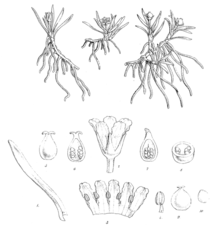Liparophyllum gunnii
From Wikipedia, the free encyclopedia
| Alpine Marshwort | |
|---|---|
 | |
| Illustration of Liparophyllum gunnii Hook.f. from J. D. Hooker, Flora Tasmaniae, vol. 1 (1860) | |
| Scientific classification | |
| Kingdom: | Plantae |
| (unranked): | Angiosperms |
| (unranked): | Eudicots |
| (unranked): | Asterids |
| Order: | Asterales |
| Family: | Menyanthaceae |
| Genus: | Liparophyllum |
| Species: | L. gunnii |
| Binomial name | |
| Liparophyllum gunnii Hook.f. [1] | |
| Synonyms[2] | |
| |
Liparophyllum gunnii, commonly known as alpine marshwort, is a species of aquatic flowering plants in the family Menyanthaceae. It is the type for the genus Liparophyllum. It is a wetland plant having a rhizomatous root structure and alternate linear leaves. Its flowers occur singly, are five-petalled, and white. Flowers bud and open from December to February; fruits form from December through April. L. gunnii is indigenous to Tasmania[3] and New Zealand.[4]
The specific epithet "gunnii" honors Ronald Campbell Gunn,[5] the collector of the type specimen of this plant.[6]
References
- ↑ The genus Liparophyllum, and its type L. gunnii, were first described and published in London Journal of Botany 6: 472bis. 1847. "Name - Liparophyllum gunnii Hook.f.". Tropicos. Saint Louis, Missouri: Missouri Botanical Garden. Retrieved November 4, 2012.
- ↑ The synonymy of L. gunnii is currently under review. "Liparophyllum gunnii Hook.f.". The Plant List; Version 1. (published on the internet). Royal Botanic Gardens, Kew and Missouri Botanical Garden. 2010. Retrieved November 4, 2012.
- ↑ "Key to Tasmanian Dicots". University of Tasmania. 2011. Retrieved November 4, 2012.
- ↑ Flora Committee (2010–2012). "Factsheet: Liparophyllum gunnii". NZFlora. Retrieved November 4, 2012.
- ↑ J.H. Maiden (1908). "18. Records of Tasmanian Botanists". "Papers and proceedings of the Royal Society of Tasmania" (Royal Society of Tasmania).
- ↑ W.J. Hooker (1847). "Liparophyllum gunnii". The London Journal of Botany VI: 473.
External links
This article is issued from Wikipedia. The text is available under the Creative Commons Attribution/Share Alike; additional terms may apply for the media files.